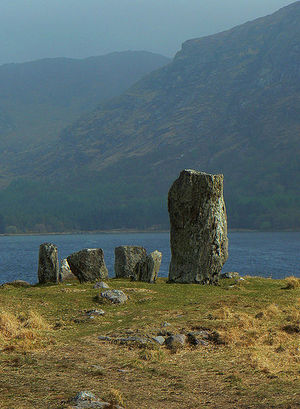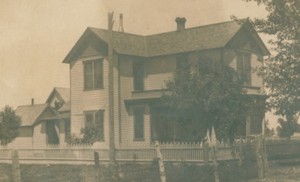Nine thousand years ago, Ireland was covered in ice, but only a thousand years later stone age settlers came into Ireland. Because of lower sea levels at the time Ireland and its British neighbors were not islands, but simply part of Europe that could be walked to. By 4000 BC, agriculture was introduced to Ireland along with goats, sheep, cattle, and cereals. By 3000 BC, the Bronze Age had begun and Irish farmers began using wheels and oxen to till the land. Alcohol and metal weaponry was also introduced.
The Iron Age is associated with the Celtic people, who were commonly believed to have conquered the people of Ireland before settling there from 600 to 150 BC. This belief is no longer held by anthropologists and historians who see evidence now that the change in culture was most likely a non violent one. In the 5th century, Christian representatives visited Ireland from Europe including Ireland’s patron Saint Patrick. These religious leaders converted the Irish from their native religions to Christianity.
By the 7th century AD, Ireland was a collection of rival tribes. The idea of a high king began to come up. This idea never fully came into fruition but for a short time, however the thought of a unified Ireland caused the tribes to create a system of law which was very successful. In the 9th century AD, a series of raids by Vikings created strife in a land already fraught with tribal warfare. The Vikings plundered Irish monasteries and towns.
In the late 12th century, Norman and English soldiers invaded Ireland and took control of it. Norman settlers began appearing in Ireland in large numbers and becoming assimilated into the population, especially around Dublin. The invasion was legitimized by papal authority, but there is some controversy over this. John Lackland became the first king of England and simultaneous Lord of Ireland. In the century that followed, Norman law began to replace the Irish law that was established in the 7th century AD. An Irish version of the Magna Carta was published in Dublin in 1216 and an Irish parliament was established in 1297.
However, in the mid 14th century, following the Black Death, Norman settling waned and Ireland began to renew its Gaelic way of ruling. By the end of the fifteenth century, English power had mostly disappeared from Ireland and renewal of Irish culture and language had occurred, though it still retained some Norman influences. The English still maintained control of the Dublin area, however, and required that the Irish Parliament answer to the English Parliament still.
In the 16th century, the Tudors of England began a reconquest of Ireland. A nearly complete conquest of Ireland occurred during the 17th century by a series of wars against Ireland by England. During these wars an estimated 20,000 Irish soldiers died and a staggering 200,000 Irish civilians due in large part to war-caused famine and guerilla action. Some historians estimate that as many as half of the pre-war Iris population died during these conflicts. In the late 17th century, religious conflicts caused a deep divide between Protestants and Roman Catholics within Ireland. Catholics were barred from taking place in government and even denied some property rights as the Anglican conformists took control of Ireland.
In 1740, a deadly mold from North America caused a potato famine, killing 400,000 people, an estimated one fourth of the Irish population. After the famine was over, Ireland went into a period of industrialization. In 1782, Ireland gave itself more independence from Great Britain than it had had since before the Normans, but the British government still maintained the parliamentary control over Ireland. In 1800, Ireland signed the Union agreement with Great Britain and became the United Kingdom of Ireland and Great Britain.
In 1840, one hundred years since that last great famine, a much larger famine occurred, causing the death of over 1 million Irish people and spurring a million others to leave Ireland, particularly for America. These deaths and mass migrations created a drop in Irish population all the way to the 1960s. Only in 2006 was Ireland back up to the population of 8.2 million that it was at before 1840.
Large groups in Ireland in the early 20th century desired to make Ireland a free and independent country. From 1919 to 1921, England launched a guerilla war against the Irish to discourage such a divide from Great Britain. The war was ended in truce with a treaty that gave Ireland independence but asked that they swear allegiance to the crown. A civil war within Ireland soon broke out between pro-treaty and anti-treaty groups, but it was soon stopped in favor of peace in 1923. With this peace agreement, Northern Ireland was to remain a part of the United Kingdom. This has caused negotiations of power between Great Britain and Northern Ireland and remains a conflict today.
Source: http://en.wikipedia.org/wiki/Ireland



